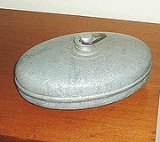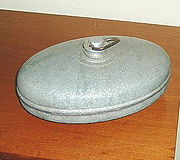
Hot water bottle
Encyclopedia


Bed
A bed is a large piece of furniture used as a place to sleep, relax, or engage in sexual relations.Most modern beds consist of a mattress on a bed frame, with the mattress resting either on a solid base, often wooden slats, or a sprung base...
, but also for the application of heat to a specific part of the body.
Containers for warmth in bed were in use as early as the 16th century. The earliest versions contained hot coal
Coal
Coal is a combustible black or brownish-black sedimentary rock usually occurring in rock strata in layers or veins called coal beds or coal seams. The harder forms, such as anthracite coal, can be regarded as metamorphic rock because of later exposure to elevated temperature and pressure...
s from the dying embers of the fire, and these bed warmer
Bed warmer
A bed warmer was a common household item in cold countries, especially Northern Europe. It consisted of a metal container, usually fitted with a handle and shaped somewhat like a modern frying pan, with a solid or finely perforated lid...
s were used to warm the bed before getting into it.
Containers using hot water were soon also used, with the advantage that they could remain in the bed with the sleeper.
Prior to the invention of rubber
Rubber
Natural rubber, also called India rubber or caoutchouc, is an elastomer that was originally derived from latex, a milky colloid produced by some plants. The plants would be ‘tapped’, that is, an incision made into the bark of the tree and the sticky, milk colored latex sap collected and refined...
that could withstand sufficient heat, these early hot water bottles were made of a variety of materials, such as zinc
Zinc
Zinc , or spelter , is a metallic chemical element; it has the symbol Zn and atomic number 30. It is the first element in group 12 of the periodic table. Zinc is, in some respects, chemically similar to magnesium, because its ion is of similar size and its only common oxidation state is +2...
, copper
Copper
Copper is a chemical element with the symbol Cu and atomic number 29. It is a ductile metal with very high thermal and electrical conductivity. Pure copper is soft and malleable; an exposed surface has a reddish-orange tarnish...
, glass
Glass
Glass is an amorphous solid material. Glasses are typically brittle and optically transparent.The most familiar type of glass, used for centuries in windows and drinking vessels, is soda-lime glass, composed of about 75% silica plus Na2O, CaO, and several minor additives...
, earthenware
Earthenware
Earthenware is a common ceramic material, which is used extensively for pottery tableware and decorative objects.-Types of earthenware:Although body formulations vary between countries and even between individual makers, a generic composition is 25% ball clay, 28% kaolin, 32% quartz, and 15%...
or wood
Wood
Wood is a hard, fibrous tissue found in many trees. It has been used for hundreds of thousands of years for both fuel and as a construction material. It is an organic material, a natural composite of cellulose fibers embedded in a matrix of lignin which resists compression...
. To prevent burning, the metal hot water flasks were wrapped in a soft cloth bag.
Rubber bottles
Modern day conventional hot water bottles are manufactured in natural rubber or PVCPVC
Polyvinyl chloride is a plastic.PVC may also refer to:*Param Vir Chakra, India's highest military honor*Peripheral venous catheter, a small, flexible tube placed into a peripheral vein in order to administer medication or fluids...
, to a design patent
Patent
A patent is a form of intellectual property. It consists of a set of exclusive rights granted by a sovereign state to an inventor or their assignee for a limited period of time in exchange for the public disclosure of an invention....
ed by the Croatia
Croatia
Croatia , officially the Republic of Croatia , is a unitary democratic parliamentary republic in Europe at the crossroads of the Mitteleuropa, the Balkans, and the Mediterranean. Its capital and largest city is Zagreb. The country is divided into 20 counties and the city of Zagreb. Croatia covers ...
n inventor Eduard Penkala
Slavoljub Eduard Penkala
Slavoljub Eduard Penkala was a naturalized Croatian engineer and inventor of Polish-Jewish ethnicity.Eduard Penkala was born in Liptovský Mikuláš , to Franjo Penkala, who was of Polish Jew heritage, and Maria Penkala , who was of Dutch heritage...
. They are now commonly covered in fabric, often with a novelty design.
By the late 20th century, the use of hot water bottles had markedly declined around most of the world. Not only were homes better heated, but newer items such as electric blanket
Electric blanket
In the US the electric blanket is a blanket with an integrated electrical heating device usually placed above the top bed sheet. In the UK and Commonwealth, electric blanket commonly refers to an electric mattress pad, which is placed below the bottom bed sheet. Electric blankets usually have a...
s were competing with hot water bottles as a source of night-time heat.
Hot water bottles remain as a popular alternative, however, in the United Kingdom and developing countries and rural areas (for example, it is widely used in Chile
Chile
Chile ,officially the Republic of Chile , is a country in South America occupying a long, narrow coastal strip between the Andes mountains to the east and the Pacific Ocean to the west. It borders Peru to the north, Bolivia to the northeast, Argentina to the east, and the Drake Passage in the far...
, where it is called a "guatero"). There has been a recent surge in popularity in Japan where it is seen as an ecologically friendly and thrifty way to keep warm.
Some newer products function like the older bottles, but use water soaked into a nonwoven material pad. These pads can be heated in a microwave oven
Microwave oven
A microwave oven is a kitchen appliance that heats food by dielectric heating, using microwave radiation to heat polarized molecules within the food...
, and they are marketed as cheaper and safer than liquid-filled bottles or electrical devices.
While generally used for keeping warm, conventional hot water bottles can be used to some effect for the local application of heat as a medical treatment, for example for pain relief; but here also, newer items such as purpose-designed heating pad
Heating pad
A heating pad is a pad used for warming of parts of the body in order to manage pain. Localized application of heat causes the blood vessels in that area to dilate, enhancing perfusion to the targeted tissue...
s are now often used.
Problems
There have been problems with premature failure of rubber hot water bottles due to faulty manufacture. The rubber may become brittle if manufacturing is not controlled closely enough. Natural rubber filled with calcium carbonateCalcium carbonate
Calcium carbonate is a chemical compound with the formula CaCO3. It is a common substance found in rocks in all parts of the world, and is the main component of shells of marine organisms, snails, coal balls, pearls, and eggshells. Calcium carbonate is the active ingredient in agricultural lime,...
is the most common material used, but is susceptible to oxidation at the high temperatures used in shaping the product. Even though the brittle cracks are not visible externally, the bottle can fracture suddenly after filling with hot water, and can scald the user.

